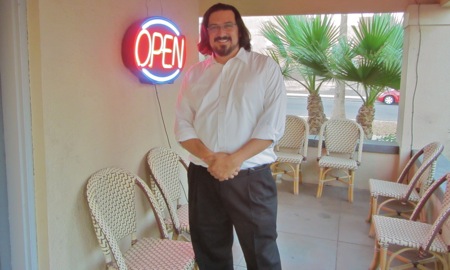Once it got cool enough to go out for a walk, Carol and I strolled over to find Lawn Gnome bookstore on 3rd St. between Roosevelt and Garfield. Along the way, we stopped at Bodega 420, a neighborhood store that carries a little bit of everything: locally produced food, canned food, ice cream, loose tobacco, condoms, playing cards, etc. We chatted with the owner, Adrian Fontes, a lawyer who runs the store in his spare time.

Adrian on the front porch of Bodega 420.
Adrian told us about the art fair that takes place on first Fridays next to his shop: artists, music, food trucks. He took us to the front porch of Bodega 420 and pointed out JoBot Coffee, some art galleries near by, the new apartment complex going up down the street, and Lawn Gnome Books. Adrian, whose family dates back over three hundred years in Arizona, said he lived for many years in Denver, and told us it was hard to leave there to return to Arizona. But now he’s excited to be in Phoenix: everyone’s from somewhere else, the city isn’t set in its ways, there’s room to innovate.
We wandered down the block to Lawn Gnome Books. I found a used copy of short stories by Joanna Russ, and Carol found The Hobo Diet, a book by someone who lived as a homeless man for five weeks in Las Vegas. Carol started talking with Billie Speece, one of the people who worked at the bookstore.

Billie in Lawn Gnome Books.
Among many other projects, Billie runs letter writing workshops at the bookstore. Years ago, Carol had been part of the Letter Exchange, and she and Billie talked about rubber stamps and mail art. Billie showed us some of the envelopes she makes from recycled paper, stitching the seams with embroidery thread. She said she is part of the Letter Writers Alliance; she added that recently AARP contacted her about her workshops.
I bought one of the handmade journals Billie sews together, using paper taken from damaged books, paper that has one side blank. One of the pages in the handmade journal I bought reads in part: “I wish Gertrude were here…. I wish she could see the man God is building on her foundation.” Another page reads: “Foods high in vitamins, minerals, and amino acids.” Carol just said, “What are you going to do with your journal?” I said I didn’t know; maybe I’ll just keep it.
Photo credits: Carol Steinfeld

